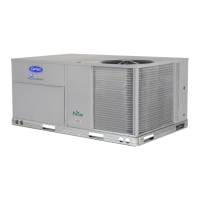18
Un it s Wit h ou t Factory--Ins ta lled
Non--Fused Disconnect or HACR —
When installing units, provide a disconnect switch per
NEC (National Electrical Code) of a dequate size.
Disconnect sizing data is provided on the unit informative
plate. Locate on unit cabinet or within sight of the unit per
national or l ocal codes. Do not cover unit informative
plate if mounting the disconnect on the unit c abinet.
All Units —
All field wiring must comply with NEC and all local codes .
Size wire based on MCA (Minimum Circuit A mps ) on the
unit informative plate. See Fig. 16 and unit label diagram for
power wiring connections to the unit power terminal block
and equipment ground. Maximum wire size is #4ga AWG
(copper only) per pole on contact ors, #4ga AWG (coppe r
only) or 1/0 AWG (copper only) per pole on optional
disconnect (max wire size depends on the disconnect size
supplied with unit), 1/0 AWG (copper only) on optional
HACR and 4/0 AWG (copper only) per pole on terminal
or fuse block on units with single point box. See Fig. 16
and unit labe l diagram for field power wiring connections.
Provide a ground--faul t and short--circuit over--current
protection device (fuse or breaker) per NEC Article 440
(or local codes). Refer to uni t informative data plate for
MOCP (Maximum Over--current Protection) device size.
All field wiring must comply with NEC and local
requirements.
NOTE: Units ordered with factory--installed HACR do
not need an addit ional ground--fault and short--circuit
over--current protective device unless required by local
codes.
All units except 208/230-v units are factory wired for the
voltage shown on the namepla te. If the 208/230-v unit is
to be connected to a 208-v power supply, the c ontrol
transformer must be rewired by moving the black wire
with the
1
/
4
-in. female spade connector from the 230--v
connec tion and moving it to the 208-v
1
/
4
-in. male
terminal on the primary side of the transformer. Refe r to
unit label di agram for additional information.
Voltage to compressor terminals during operation must be
within voltage range indicated on unit nameplate. On
3--phase units, voltages between phases must be balanced
within 2% and the current within 10%. Use the formula
below to determine the percent of voltage imbalance.
%Voltage
Imbalance
= 100 x
max voltage deviation from average voltage
average voltage
Example: Supply voltage is 230-3-60
AB = 224 v
BC = 231 v
AC = 226 v
Average Voltage =
(224 + 231 + 226)
=
681
= 227
3
3
Determine maximum deviation from average voltage.
(AB) 227 – 224 = 3 v
(BC) 231 – 227 = 4 v
(AC) 227 – 226 = 1 v
Maximum deviation is 4 v.
Determine percent of voltage imbalance.
%VoltageImbalance
= 100 x
4
= 1.76%
227
This amount of phase imbalance is satisfactory as it is below the
maximum allowable 2%.
IMPORTANT: If the supply voltage phase imbalance is more than
2%, contact your local electric utility company immediately.
Operati on on improper l ine volt age or excessive phase
imbalance constitutes abuse and may cause damage to
electrical components. Such ope ration would invalidate
any applicable Carrier warranty.
NOTE: Check all factory and field electrical connections
for tightness.
Convenience Outlets —
ELECTRICAL OPERATION HAZARD
Failure to follow this warning could result i n personal
injury or death.
Units with convenience outlet circuits may use
multiple disconnects. Check convenience outlet for
power status before opening unit for servic e. Locate
its disconnect switch, if appropriate, and open i t.
Lock--out and tag--out this switch, if necessary.
!
WARNING
Two types of convenience outlets are offered as
fact ory--installed options on 50HC models: Non--powered
and unit--powered. Both types provide a 125--vol t GFCI
(ground--fault circuit--interrupter) duplex receptacle rated
at 15--A behind a hinged waterproof access cover, located
on the end panel of the unit. See Fig. 22.
A 20 amp non--powered convenience outlet is available as
a field--installed accessory.
Convenience
Outlet
GFCI
Pwd-CO
Fuse
Switch
Pwd-CO
Transformer
Control Box
Access Panel
C08128
Fig. 22 -- Convenience Outlet Location
Non--powered type: This type requires the field
installation of a gene ral --purpose 125--volt 15--A circuit
powered from a source elsewhere in the building. Observe
national and local codes when selecting wire size, fuse or
breake r requirements and disconnect switch size and
loca tion. Route 125--v power supply conductors into the
bottom of the utility box containing the duplex receptacle.

